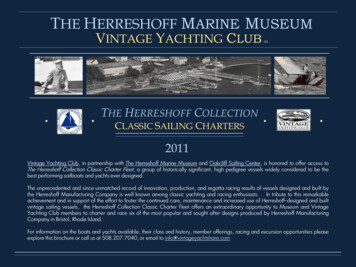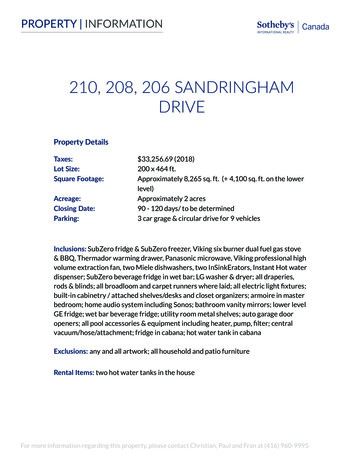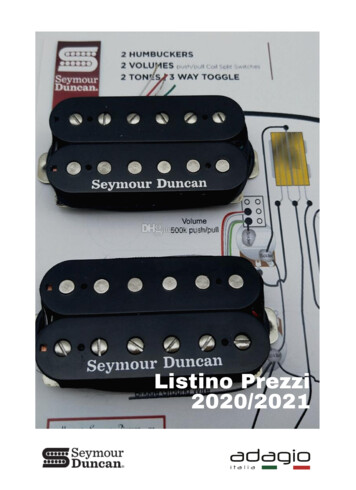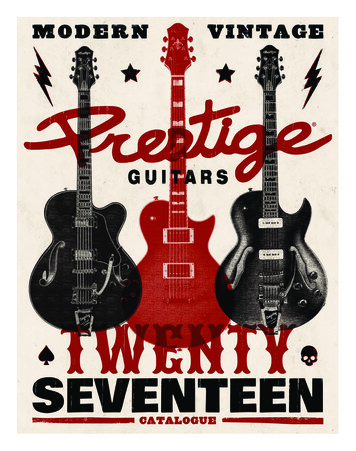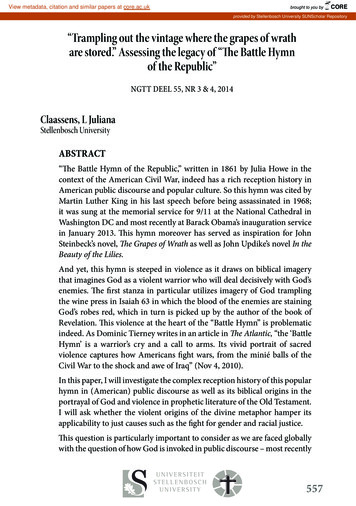
Transcription
View metadata, citation and similar papers at core.ac.ukbrought to you byCOREprovided by Stellenbosch University SUNScholar Repository“Trampling out the vintage where the grapes of wrathare stored.” Assessing the legacy of “The Battle Hymnof the Republic”NGTT DEEL 55, NR 3 & 4, 2014Claassens, L JulianaStellenbosch UniversityABSTRACT“The Battle Hymn of the Republic,” written in 1861 by Julia Howe in thecontext of the American Civil War, indeed has a rich reception history inAmerican public discourse and popular culture. So this hymn was cited byMartin Luther King in his last speech before being assassinated in 1968;it was sung at the memorial service for 9/11 at the National Cathedral inWashington DC and most recently at Barack Obama’s inauguration servicein January 2013. This hymn moreover has served as inspiration for JohnSteinbeck’s novel, The Grapes of Wrath as well as John Updike’s novel In theBeauty of the Lilies.And yet, this hymn is steeped in violence as it draws on biblical imagerythat imagines God as a violent warrior who will deal decisively with God’senemies. The first stanza in particular utilizes imagery of God tramplingthe wine press in Isaiah 63 in which the blood of the enemies are stainingGod’s robes red, which in turn is picked up by the author of the book ofRevelation. This violence at the heart of the “Battle Hymn” is problematicindeed. As Dominic Tierney writes in an article in The Atlantic, “the ‘BattleHymn’ is a warrior’s cry and a call to arms. Its vivid portrait of sacredviolence captures how Americans fight wars, from the minié balls of theCivil War to the shock and awe of Iraq” (Nov 4, 2010).In this paper, I will investigate the complex reception history of this popularhymn in (American) public discourse as well as its biblical origins in theportrayal of God and violence in prophetic literature of the Old Testament.I will ask whether the violent origins of the divine metaphor hamper itsapplicability to just causes such as the fight for gender and racial justice.This question is particularly important to consider as we are faced globallywith the question of how God is invoked in public discourse – most recently557
CLAASSENS, L JULIANA in my South African context by President Jacob Zuma, who famously hassaid that the ANC would rule until Jesus will come again. In an addressto the 33rd Presbyterian Synod in Giyani, Limpopo in October 2013, PresZuma is reported to have invoked the wrath of God upon those individualswho do not respect his leadership, raising disconcerting questions regardingthe link between divine violence and violence in political discourse.CONTACT DETAILSProf Julie ClaassensProfessor of Old Testament, Department of Old and New TestamentFaculty of Theology, Stellenbosch UniversityPrivaatsak X1, Matieland, Suid-Afrika, 7602jclaassens@sun.ac.za5582014 PIETER DE WAAL NEETHLING TRUST
NGTT DEEL 55, NR 3 & 4, 20141. INTRODUCTIONMine eyes have seen the glory of the coming of the Lord;He is trampling out the vintage where the grapes of wrath are stored;He hath loosed the fateful lightning of His terrible swift sword;His truth is marching on.Glory! Glory! Hallelujah! Glory! Glory! Hallelujah!Glory! Glory! Hallelujah! His truth is marching on.In a striking music video that employs images from the Second World War asbackground for the “Battle Hymn of the Republic,”1 one moment in the veryinteresting history of reception of this popular hymn is captured thanks to thewonders of YouTube. This hymn that had its origin in the Civil War in the UnitedStates and initially had the purpose to inspire people who were fighting for theabolishment of slavery now has transcended its original context and has beenapplied to another (just) cause.My interest in this hymn and its reception was first sparked by the vivid imageryin stanza 1 that employs the image of God as a Divine Warrior who is treading the“grapes of wrath” in the wine press. In this image that first appears in Isaiah 63:16 and is picked up again by the book of Revelations (14:19-20), we read how the“blood” of the grapes is staining God’s robe red. In a moment of recognition, thereader realizes with shock that the “grapes” that the Divine Warrior is treading, areactually the heads of the enemy soldiers.This exceedingly violent image that has found its way into the “Battle Hymn” istroubling indeed. Particularly if one considers the many violent contexts in whichthis hymn with its utterly catchy melody has resounded. As part of a larger projectthat deals with the violence in the biblical prophets,2 I have been contemplating thelink between such violent God-language that has found its way into the popular“Battle Hymn” and its violent hearers.In my search to understand the “wirkungsgeschichte” of this song, I have found afascinating book that outlines the biography of this famous hymn. In their book, TheBattle Hymn of the Republic: A Biography of the Song that Marches On, John Staufferand Benjamin Soskis show how the intriguing history of reception of this hymnis indeed multifaceted. In compelling fashion, the book narrates not only how the12Available at http://youtu.be/kR7HPQM0Jgg Accessed April 7, 20014.“Violence in the Prophetic Rhetoric,” in Oxford Handbook to the Prophets (Oxford:Oxford University Press, forthcoming).http://ngtt.co.za559
CLAASSENS, L JULIANA “Battle Hymn” came into being, but also the various contexts in which this hymn,and its offshoots, has become significant.3In this paper, I will introduce some of the highlights of this journey of a hymn thatraises all sorts of questions regarding the link between God and violence that isassumed in both the Old Testament text of Isaiah 63 as well as the subsequent text ofRevelations 14. I will ask whether the violent origins of the divine metaphor hamperits applicability to other just causes such as the fight for gender and racial justice.2. THE ROOTS OF THE BATTLE HYMNThe “Battle Hymn” actually had its origin in a popular song remembering thefreedom fighter John Brown, who in 1859 staged a massive slave insurrection, andultimately was captured, trialled and hanged.4 After his death, all around the countrythe following words resounded on the melody that later would become the “BattleHymn:”John Brown’s body lies mouldering in the graveHis soul’s marching on.Chorus:Glory, Hally, HallelujahGlory, Hally, HallelujahHis soul’s marching on.He’s gone to be a solider in the army of the Lord.5During the time of the Civil War, John Brown and his song increasingly served asthe anthem in the struggle for emancipation.6 “The song’s power to fuel and sustaindefiance” is captured by one commentator’s characterization of the words of “JohnBrown’s Body” being “the verbal equivalents of rifle-bullets and cannon-balls.”734567John Stauffer and Benjamin Soskis, The Battle Hymn of the Republic: A Biography of theSong that Marches On (Oxford: Oxford University Press, 2013).Stauffer and Soskis note that John Brown became one of America’s most contentiousfigures. Some would consider him to be the “freedom fighter” per excellence, for others,he was “a dangerous fanatic,” Battle Hymn of the Republic, 28.Cited in Stouffer and Soskis, Battle Hymn of the Republic, 294.Stauffer and Soskis, Battle Hymn of the Republic, 63.Stouffer and Soskis, Battle Hymn of the Republic, 67.5602014 PIETER DE WAAL NEETHLING TRUST
NGTT DEEL 55, NR 3 & 4, 2014After a visit to a Union Camp on the banks of the Potomac River near WashingtonDC in 1861, Julia Howe wrote more dignified8 words to John Brown’s song, drawingheavily on the apocalyptic imagery found in the book of Revelations as well as inprophets like Isaiah, Ezekiel, Joel and Daniel. Stauffer and Soskis note that mostAmericans at this time would have recognized these images – many who harbouredstrong millenialist sentiments, i.e., the conviction that Jesus will come very soon.9Even though Howe in all likelihood had the text from Rev 14:19-20 in mind, themetaphor of God as the mighty warrior being victorious over the enemies as evidentin the image of God “trampling out the vintage where the grapes of wrath are stored”first appears in the context of Isaiah. Much has been written as to how to deal withthe violent imagery that is used for God in both the Old and New Testament.10One way of making sense of the violent imagery used in Isaiah which reappears inthe book of Revelations, is that it emerged from a context of extreme trauma. Theexperience of war, or at least the threat of war, had a marked effect on the imageryused – the violent imagery likely being a response to the violence effected by theEmpire (in the case of Isaiah for the most part the Babylonian Empire, and in thecase of Revelations, the Roman Empire).11 It may well be that the violent context(s)presumed in the biblical tradition and in particular the image of a mighty Deliverer8Dominic Tierney writes in his article, “The Battle Hymn of the Republic': America's Songof Itself,” how the lyrics of “John Brown’s hymn” were considered rather unbecoming.Apparently the popularized version of one of the lines changed the published version:“We'll hang old Jeff Davis from a sour apple tree,” to “We'll feed Jeff Davis sour apples'til he gets the diarhee.” The Reverend James Clarke liked the melody but asked JuliaHowe to write less crude lyrics, The Atlantic, Nov 4 (2010). Available at ngof-itself/66070/2/ Accessed April 5, 2014.9 Stouffer and Soskis, Battle Hymn of the Republic, 86-88.10 Cf the excellent collection of essays Aesthetics of Violence in the Prophets (ed. ChrisFranke and Julia M O’Brien; Sheffield: T&T Clark, 2010); Eric Seibert, The Violenceof Scripture: Overcoming the Old Testament’s Troubling Legacy (Minneapolis: FortressPress, 2012). Other works include: David A Bernat and Jonathan Klawans, eds. Religionand Violence: The Biblical Heritage (Sheffield: Sheffield Phoenix, 2007); Jeremy Young,The Violence of God and the War on Terror (New York: Seabury, 2007).11 Cf the pioneering work done in this regard by Daniel L Smith-Christopher, A BiblicalTheology of Exile (Overtures to Biblical Theology; Minneapolis, MN: Fortress Press,2001), Kathleen O’Connor, Jeremiah: Pain and Promise (Minneapolis: Fortress Press,2011). Cf also the newly constituted “Biblical Literature and the Hermeneutics ofTrauma” section of the Society of Biblical Literature.http://ngtt.co.za561
CLAASSENS, L JULIANA God who will save Israel from her enemies,12 offered a natural point of connectionto later generations’ hope for deliverance from whatever the real or perceived enemywould be at the time.It remains a question though whether the divine violence depicted in these textsactually does lead to human violence?13 One suggestion has been that to imagine astrong and mighty God who will definitively remove the enemy constitutes a typeof wish fulfilment, which actually may prevent humans from engaging in violencethemselves.14 In the rest of this paper, this suggestion will be tested in light ofthe various applications of this hymn as outlined by Stauffer and Soskis in theirfascinating description of the journey of the “Battle Hymn.”12 Cf Corrine Carvalho’s article, “The Beauty of the Bloody God: The Divine Warrior inProphetic Literature,” [in Aesthetics of Violence in the Prophets (ed. Chris Franke andJulia M. O’Brien; Sheffield: T&T Clark, 2010), 135] in which she argues that “Christiantheologians seem to want a pacifist messiah, a non-bloody kingdom, an effortlessvictory. And yet the success of contemporary films reveals the deficiency of this viewof non-violent salvation for many believers. American audiences, at least, like ourmessiahs to have rippling muscles, sweat-dripped arms, and a well-stocked arsenal.”Cf for example the image of Neo from The Matrix which is in line with the Americancowboys to recent futuristic “sci-fi” warriors.13 This topic will be dealt with more extensively in my article on Violence in the Prophetsin the Oxford Handbook of Prophets. In this regard, Eric Seibert point out that thedesignation “violent texts” is not “entirely satisfactory since texts themselves are notviolent. They are mere words on a page, not autonomous agents. Although violenttexts, like violent movies, have the power to portray violence, they do not, in and ofthemselves, have the power to perpetrate it. Violent texts do not kill people any morethan violent movies do. Although both might be a source of ‘inspiration’ for suchdiabolical deeds, neither a text nor a film can actually kill.” And yet, Seibert who goeson to speak about the violent legacy of the biblical text also argue that one should“not underestimate the enormous influence these texts can have on readers, one thatfrequently results in rather accommodating views toward violence.” The Violence ofScripture, 10.14 Cf Jonathan Klawans’ comment that “violent fantasies may have served originally todeflect or channel the rage that could otherwise lead to real violence. But once thesefantasies are canonized, they may find their way into the hands of groups who acceptwithout question their own self-righteousness and their enemies’ evil nature,” “Religion,Violence and the Bible,” in Religion and Violence, 14.5622014 PIETER DE WAAL NEETHLING TRUST
NGTT DEEL 55, NR 3 & 4, 20143. JOURNEY OF A HYMN(a) Times of warAs was evident in the opening clip, the “Battle Hymn” is first and foremost a songof war. Stauffer and Soskis rightly point out that “rooted in the emancipatoryimperatives of the Civil War, the hymn has allowed subsequent generations ofAmericans to perceive their own engagements – in Cuba, in the Philippines, in thefields of France, and in the jungles of Vietnam – as the most recent fulfilment oftheir millennial mission to make men free.”15For instance, even though Woodrow Wilson at the time of the First World Warfamously would have said that “war isn’t declared in the name of God, it is a humanaffair entirely,” the “Battle Hymn” framed Wilson’s message announcement thatthe United States would join the war. Several newspapers distributed Wilson’s warmessage printed along the words of the Battle Hymn.16 Wilson himself cited the“Battle Hymn” as a means of understanding American’s role in the Great War. Ata Red Cross Fundraising event in 1918, he said that the “‘oppressed and helpless’peoples of the world” should perceive of the “Battle Hymn” as a hymn of liberationthat has the purpose of setting them and their children free.17 Similarly, FranklinDelano Roosevelt during the Second World War would depict “the war againstNazism and fascism as a crusade the American people would take on ‘in theirrighteous might’ against the forces of ultimate evil.”18 Once again the “Battle Hymn”15 Stouffer and Soskis, Battle Hymn of the Republic, 12. Dominic Tierney describes “the‘Battle Hymn’ is a warrior's cry and a call to arms. Its vivid portrait of sacred violencecaptures how Americans fight wars, from the minié balls of the Civil War to the shockand awe of Iraq,” “The Battle Hymn of the Republic.” Cf also Tierney’s book, How WeFight: Crusades, Quagmires, and the American Way of War (Little, Brown and Company,2010).16 Stouffer and Soskis, Battle Hymn of the Republic, 167. The fact that Wilson’s war resolutiontook place during Holy Week underscored the fact that America’s contribution to theFirst World War was seen as a Holy War. Cf also a sermon by Reverend RandolphMcKim cited by Dominic Tierney: “It is God who has summoned us to this war. It ishis war we are fighting . This conflict is indeed a crusade. The greatest in history – theholiest.” Tierney rightly points out that there is no separation between church and statein this application of the hymn, “The Battle Hymn of the Republic.”17 Stouffer and Soskis, Battle Hymn of the Republic, 168-169. And yet during World War 1,the “Battle Hymn” was also embraced by people around the world. Many Britons sangthis hymn during their church services, 11.18 Stouffer and Soskis, Battle Hymn of the Republic, 274.http://ngtt.co.za563
CLAASSENS, L JULIANA played a prominent role in rallying the American troops to fight what was consideredto be a noble cause.19This application of the “Battle Hymn” in times of war is open for abuse though.Stauffer and Soskis tell a chilling story that comes from America’s involvement inVietnam. On March 29, 1971, Second Lieutenant William L Calley was found guiltyand sentenced to life in prison for masterminding the My Lai massacre, which sawthe premeditated murder of twenty-two Vietnamese.20 All across the AmericanSouth, radio stations played a parody of the “Battle Hymn” called the “Battle Hymnof Lt Calley” in which an aggrieved Lt Calley proclaimed, “he and his men simplyhad been doing their duty.” As one of the stanzas says:When I reach my final campgroundin that land beyond the sunAnd the great commander asks me,“Did you fight or did you run?”I’ll stand both straight and tallstripped of medals, rank and gunand this is what I’ll say:Sir, I followed all my orders and Idid the best I couldIt’s hard to judge the enemy andhard to tell the goodYet there’s not a man among uswould not have understoodWe took the jungle village exactlylike they said 2119 Cf the example of Brigadier General Theodore Roosevelt Jr (eldest son of formerpresident Teddy Roosevelt) who started singing the “Battle Hymn” as he walked amongthe troops who were approaching the Normandy coast of what would become D-Day,urging them to sing along, Stauffer and Soskis, Battle Hymn of the Republic, 275. Cf alsothe role hymns like the “Battle Hymn” in addition to “America” and “The Star SpangledBanner” in “americanizing” immigrants. Stauffer and Soskis write how immigrantsoldiers, many who could not speak English, were “made Americans through song,”171.20 Stouffer and Soskis, Battle Hymn of the Republic, 279.21 “Battle Hymn of Lt. Calley,” (From C Company featuring Terry Nelson with JulianWilson, James M Smith, Plantation Records, 1971). Cited in Stauffer and Soskis, BattleHymn of the Republic, 300-302. In another stanza, a contrast is drawn between the5642014 PIETER DE WAAL NEETHLING TRUST
NGTT DEEL 55, NR 3 & 4, 2014Stauffer and Soskis note “Calley’s hope for redemption lies not in this world butin the next.” When Calley is said to enter the “final campground” and the “greatcommander” asks of him: “Did you fight or did you run?” Calley answers in the finalstanza: “Count me only as a soldier who never left his gun.’”22(b) The war against poverty and injusticeThe “Battle Hymn” was also employed in a battle of another kind. Already in a famousparody of the “Battle Hymn” published in 1901, Mark Twain critiques the “callouseconomic interest” that lies behind the “lofty imperial rhetoric” in this hymn:“Mine eyes have seen the orgy of the launching of the Sword greed was born in yonder ditch;with a longing in his bosom –for other’s goods an itch;Christ died to make men holylet men die to make us rich;Our god is marching on.”23This prophetic critique underlying Mark Twain’s parody of the “Battle Hymn” iscontinued in the critical voice regarding the effects of economic depression andenvironmental disaster that is at work in John Steinbeck’s novel, The Grapes of Wrath(a reference drawn from the first stanza of the “Battle Hymn”).24 In this novel, JohnSteinbeck outlines the ill-fated story of the Joad family who, after experienced thedevastating effects of the Oklahoma Dust Bowl, sought their fortune in California.As Stauffer and Soskis write, “for Steinbeck, the reference to the ‘Battle Hymn’suggested the nation’s ‘own revolutionary tradition’ which he believed an indigenoussoldiers who were “fighting in the jungles” and “dying in the rice fields” while the antiwar protesters “were marching in the street” and thus actually “were helping our defeat,”and in an ironic twist on the original hymn, “sounding a retreat, as we go marchingon ”22 Stouffer and Soskis, Battle Hymn of the Republic, 280.23 Stouffer and Soskis, Battle Hymn of the Republic, 134-135.24 In a sermon that cites John Steinbeck’s reference to the “Battle Hymn,” Joyce ParryMoore states that “when crops are destroyed to keep prices high, while people arestarving,” John Steinbeck writes that “in the eyes of the hungry there is a growing wrath.In the souls of the people ‘the grapes of wrath’ are filling and growing heavy, growingheavy for the vintage,” “Trampling the Grapes of Wrath” [August 18, 2013] Proper15, 13th Sunday after Pentecost, http://www.saintbartslivermore.com/sermon 081813.phpAccessed April 5, 2014.http://ngtt.co.za565
CLAASSENS, L JULIANA movement of small farmers and workers had honoured as they battled against theirmoneyed oppressors during the Depression.”25It was quite important for Steinbeck to include the entire “Battle Hymn” in thebeginning of his novel in order to avert the critique that he and his book wascommunist. For Steinbeck, the explicit reference to the “Battle Hymn” in the titleof his book, as well as the hymn that was printed together with its song sheet, istestimony of the fact that his book is truly American, “speaking to the nation’s hopesand fears.”26Another interesting parody on the “Battle Hymn” that features in the war againstpoverty and injustice was inspired by a “Hunger March” organized January 17, 1915by the League of the Unemployed in Chicago. This public protest sought to highlightthe extreme poverty facing America during which almost half of the nation’spopulation subsisted on a “near-starvation level.”27 In the hymn, “Solidarity Forever”that employs the melody and the sentiment of the “Battle Hymn,” a member of theInternational Workers of the World Union, Ralph Chapman, wrote the followingwords that would become quite popular among those fighting against injustice:28Is their aught we hold in common withthe greedy parasite,Who would lash us into serfdom andwould crush us with his might?Is there anything left for us but to organize and fight?For the Union makes us strong.In our hands is placed a power greaterthan their hoarded gold;Greater than the might of armiesmagnified a thousand fold.We can bring to birth the new worldfrom the ashes of the oldFor the Union makes us strong.292526272829Stouffer and Soskis, Battle Hymn of the Republic, 174.Stouffer and Soskis, Battle Hymn of the Republic, 175.Stouffer and Soskis, Battle Hymn of the Republic, 175.Stouffer and Soskis, Battle Hymn of the Republic, 176, 179.Stouffer and Soskis, Battle Hymn of the Republic, 180-181.5662014 PIETER DE WAAL NEETHLING TRUST
NGTT DEEL 55, NR 3 & 4, 2014Stauffer and Soskis note that the new lyrics to the old hymn had the intentionof inspiring “people to fight and die in this new civil war for a new transcendentunion.”30 In changing the lyrics, Chaplin recovered the “Battle Hymn’s” originalradicalism in terms of its abolitionist past.31(c) The fight for civil rightsThe “Battle Hymn” has become the anthem of many different groups fighting forjustice. Dominic Tierney writes how already in 1890, “women’s rights campaigners”adopted their own version: “Battle Hymn of the Suffragists” with the following lyrics:“They come from every nation, women fair and strong and brave.”32The “Battle Hymn” also played a central role in the Civil Rights movement of the1950s and early 1960s. Stauffer and Soskis narrate how Civil Rights activists sangthis hymn when they marched, when they were jailed as a means of bolstering theirspirits during those most difficult times that marked the fight for civil rights.33No more is this evident than in the speeches of Martin Luther King. Martin LutherKing often cited the “Battle Hymn” invoking the hymn’s familiar imagery – a greatexample of this the following clip that outlines a speech he gave after the third marchto Montgomery which grew to 25 000 protestors.34 In his speech, he used the imageof the “march,” telling the audience that they need to continue to march againstsegregation, poverty and for the right to vote. Using the characteristic call-andresponse technique, King asked the audience “How long?” with the audience callingback, “Not long.” By invoking the first stanza of the “Battle Hymn,” King remindedhis audience that the power of God’s truth is marching on.35 As Stauffer and Soskisdescribe King’s use of this hymn:30 Stouffer and Soskis, Battle Hymn of the Republic, 180. It is significant that “SolidarityForever” never directly invokes God, attesting to the fact that “the millennialist fervorof the original” had thoroughly been secularized, p 181. On the other hand, for LiberalProtestants at this time, who would also invoke the “Battle Hymn,” God’s kingdomwere thought to come through an “ongoing, continuous process of social and moralimprovement, revealed in safe and productive factories in a fairer distribution ofwealth, and in the discovery of vaccines,” 156.31 Stouffer and Soskis, Battle Hymn of the Republic, 188.32 Tierney, “The Battle Hymn of the Republic.”33 Stouffer and Soskis, Battle Hymn of the Republic, 240.34 Available at http://youtu.be/TAYITODNvlM Accessed April 7, 2014.35 Stouffer and Soskis, Battle Hymn of the Republic, 257-258.http://ngtt.co.za567
CLAASSENS, L JULIANA In the Montgomery speech’s final lines King reaches for the ‘Battle Hymn’to cultivate urgency and to combat passivity in the face of the challengesahead. The hymn’s millennial framework helped to put the movement’sfrustrations into an eschatological context the millennium of racialjustice was at hand; God was coming.36Martin Luther King’s use of this hymn is marked by two main themes: First, by usingthe “Battle Hymn,” he is drawing on the original intention of the hymn, i.e. the fightto free the African American slaves. Hundred years later, the civil rights activistswere engaged in a new battle, i.e., a battle for freedom and equality. However,throughout out his life, Martin Luther King was overtly committed to non-violence,which raises some questions about the violent imagery of the “Battle Hymn” that sooften marked King’s rhetoric. King himself discussed this use of violent imagery inthe battle for civil rights when he says: “We did not hesitate to call our movement anarmy but it was a special army that would sing but not slay.”37Second, in the final months and weeks of his life, King is said to have suffered from agrowing sense of despair – a result of experiencing a lot of adversity. He increasinglysaw his own role in terms of the suffering Christ – in a speech to an SCLC gatherin 1967 he says that his own work may get him crucified; that he actually may die.However citing the “Battle Hymn,” he says: “ even if I die in the struggle that ‘Hedied to make men free.’”38 This is no more evident than in King’s chilling last speechin which he admits that he would have liked to live a long life. However, like Moses,God had allowed him to go up the mountain and to see the Promised Land, whichthe people are about to enter, even though King himself may not actually get there.He ends his final speech before being assassinated the following day once morewith a reference from the “Battle Hymn.” After saying that he fears nothing and noperson, he concludes: For “Mine eyes have seen the glory of the coming of the King.”In his speech, King thus merges the “Battle Hymn’s” belief in the imminence of thecoming of God’s kingdom with his own “act of Christ-like sacrifice.”3936373839Stouffer and Soskis, Battle Hymn of the Republic, 258.Cited in Stouffer and Soskis, Battle Hymn of the Republic, 259.Stouffer and Soskis, Battle Hymn of the Republic, 252.Stouffer and Soskis, Battle Hymn of the Republic, 267. In a speech to psychologists inSeptember 1967, King admitted to being very tired now, saying that he had been fightingthis battle for thirteen years. Stauffer and Soskis note the ominous note that started tomark King’s speeches and sermons as he increasingly focused on the judgment of Godthat would fall upon America, 262.5682014 PIETER DE WAAL NEETHLING TRUST
NGTT DEEL 55, NR 3 & 4, 2014Finally, it is ironic indeed that after Martin Luther King’s death, violent protestserupted all throughout America with 39 individuals being killed and 3 500 wounded.One protester is said to have shouted: “He died for us, and we’re going to die for him”in what Stauffer and Soskis call a “grim echo of the concluding lines of the ‘BattleHymn.’” And in Minneapolis, a black man vowed to shoot the first white person hesaw. Violently killing his neighbour, he cried: “My King is dead.”40(d) Right-wing battlesStauffer and Soskis outline how the “Battle Hymn” became a favourite of Evangelicals,embraced by the evangelist Billy Sunday, whose epic revivals in the early part of the20th century offered the inspiration for the later Billy Graham.41 Stauffer and Soskisnote that while the Progressive Party embraced the “Battle Hymn” as an anthemfor social reform, it was utilized by Evangelicals such as Sunday and Graham tocommunicate the importance of “battling sin and accepting Christ as one’s personalSaviour.”42 They continue to say that “the hymn’s lyrical, symbolic, and allusivelanguage had freed it from its abolitionist context during the Civil War, permittingit to be adapted and constantly updated” by Evangelicals such as Sunday “in fightingnew conflicts and vanquishing new evils in yet another impending Armageddon.”43Interestingly enough, while Sunday’s primary enemies to be eradicated were liquorand the trafficking of liquor, Graham’s battle was against communism and the USSR“which threatened the United States both morally and militarily.”44One interesting story that encapsulates the “Battle Hymn’s” prominent role in thewar against communism regards the Dayton, Ohio disk jockey who during the visitof the Russian president Nikita Khrushchev in September 1959, played the “BattleHymn” non-stop “so that the Soviet leader might hear ‘the sound of freedom.’”45 Andwhen the
“grapes of wrath” in the wine press. In this image that first appears in Isaiah 63:1-6 and is picked up again by the book of Revelations (14:19-20), we read how the “blood” of the grapes is staining God’s robe red. In a moment of recognition, the reader realizes with shock that the “




